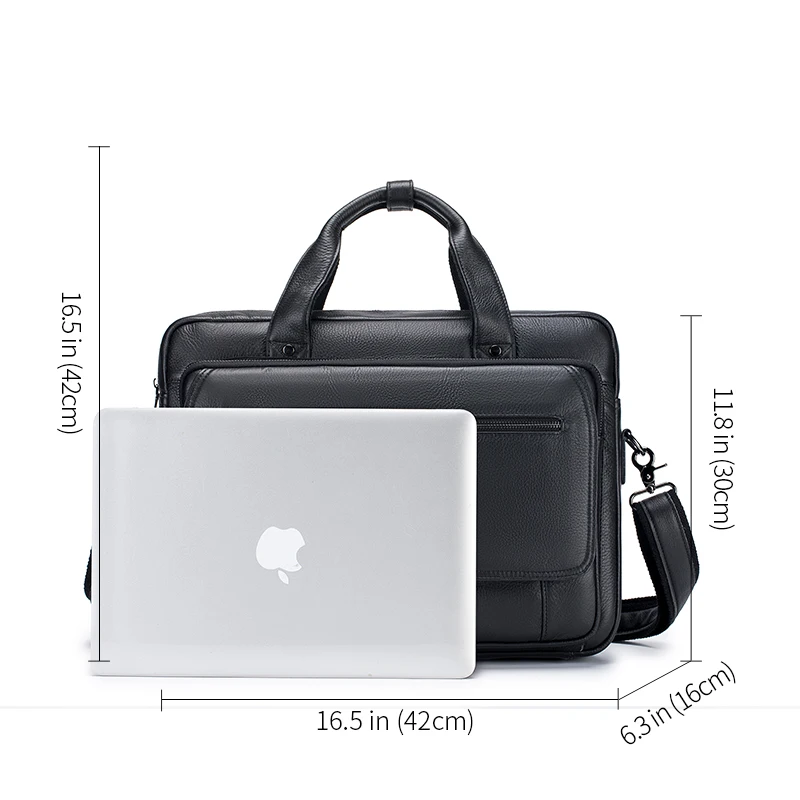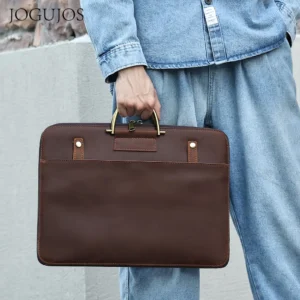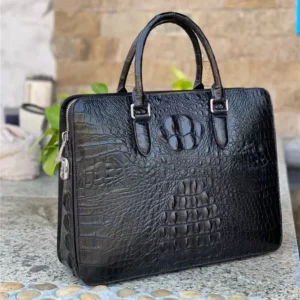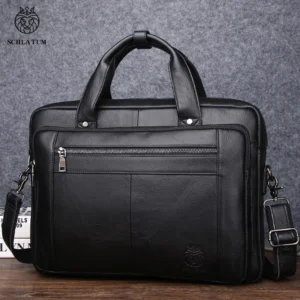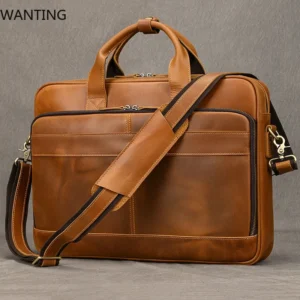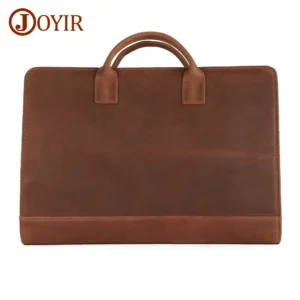Introduction: The Value of Regular Leather Briefcase Maintenance
A quality leather briefcase is more than just a way to carry your documents—it’s an investment in your professional image and daily functionality. These sophisticated accessories often represent a significant financial commitment, with high-quality options starting at $200-$500 or more. However, with proper care, a well-maintained leather briefcase can serve you faithfully for over a decade, while neglected ones might deteriorate in just 2-3 years.
The difference between a briefcase that ages gracefully and one that quickly looks worn comes down to consistent maintenance. Leather is a natural material that responds remarkably well to regular care but can deteriorate rapidly when neglected. Establishing a simple care routine protects your investment while ensuring your timeless classic leather briefcase continues to make a positive impression in professional settings.
Different leather types require slightly different approaches to care, but all benefit from a comprehensive maintenance system. In this guide, we’ll explore the complete process of cleaning, conditioning, protecting, and properly storing your leather briefcase to maximize its lifespan and preserve its elegant appearance. The classic leather briefcases in our collection deserve this level of attention—and with the right knowledge, you’ll find the maintenance process surprisingly simple and rewarding.
Understanding Your Leather Briefcase: Know What You’re Working With
Before reaching for any cleaning products, it’s essential to understand exactly what type of leather makes up your briefcase. Leather is a natural material that “lives” and changes over time, developing character with proper care. Different leather types have distinct characteristics that affect how they should be maintained:
Full-grain leather: The highest quality option, featuring the complete grain with all natural markings. It’s extremely durable but requires regular conditioning to maintain flexibility. This leather develops a beautiful patina over time when properly maintained.
Top-grain leather: The second-highest grade, where the uppermost layer has been sanded and refinished. Slightly less durable than full-grain but more resistant to stains. Requires regular but less frequent conditioning.
Corrected-grain leather: Has been sanded to remove imperfections and embossed with an artificial grain pattern. More uniform in appearance but generally less durable. Requires less maintenance but won’t develop the same rich patina.
Specialty leathers: This includes suede (buffed to create a napped surface), patent leather (coated with a high-gloss finish), and exotic leathers. Each has very specific care requirements.
To identify your briefcase’s leather type, examine its appearance and feel. Full-grain leather shows natural markings and imperfections, while corrected leathers look more uniform. The documentation that came with your briefcase may also specify the leather type. Another simple test: place a small drop of water on an inconspicuous area. On full-grain leather, it will bead up temporarily before slowly absorbing, while on heavily finished leathers, it will sit on the surface longer.
The finish applied to your leather also matters. Aniline leather has minimal coating, allowing the natural grain to show through but offering less protection. Semi-aniline has a light protective coating, while pigmented leather has a heavier protective layer that masks the natural grain. Understanding these differences is fundamental to providing appropriate care, as the benefits of full-grain leather bags extend beyond just appearance to include how they respond to maintenance efforts.
Essential Leather Care Supplies: Building Your Maintenance Kit
Creating a basic leather care kit ensures you’ll have everything needed to maintain your briefcase properly. Here’s what you should include:
| Item | Purpose | Selection Tips |
|---|---|---|
| Soft cloths | Cleaning, applying products, buffing | Use lint-free, microfiber, or 100% cotton cloths |
| Leather cleaner | Removing dirt and stains | Choose pH-balanced cleaners specifically for leather |
| Leather conditioner | Moisturizing and preventing drying/cracking | Select products appropriate for your leather type |
| Soft brush | Removing dust from seams and textures | Use horsehair brushes for gentle cleaning |
| Leather protector spray | Creating a barrier against moisture/stains | Avoid silicone-based products that can damage leather |
| Applicator pads | Even application of conditioners | Foam or chamois applicators work best |
| Dust bag | Proper storage | Cotton or flannel bags allow leather to breathe |
| Leather edge coat (optional) | Maintaining finished edges | Match the color to your briefcase edges |
Quality matters when selecting these products. Inexpensive leather cleaners may contain harsh chemicals that damage leather over time. Similarly, conditioners with petroleum derivatives might provide short-term shine but can degrade stitching and glue. When in doubt, less is more—gentle products used properly will extend your briefcase’s life significantly.
Having the right tools ready ensures you can implement all maintenance steps properly and safely. For specific recommendations that match the quality of our men’s classic leather briefcase collection, our customer service team can provide personalized guidance.
Routine Daily and Weekly Care: Prevention Is Better Than Cure
The most effective leather care strategy emphasizes prevention through simple, consistent habits:
Daily Routine (30 seconds)
1. Wipe your briefcase with a soft, dry cloth at the end of each day to remove dust and oils from handling
2. Check for any spills or marks and address them immediately
3. Empty the contents and allow the bag to rest in its natural shape
4. Handle with clean hands, avoiding contact with lotions or hand sanitizers
Weekly Routine (5 minutes)
1. Perform a more thorough dust removal, including seams and hardware
2. Empty the briefcase completely and gently clean the interior with a slightly damp cloth
3. Inspect for any developing issues like scratches, scuffs, or dry areas
4. Check hardware for proper function and early signs of tarnishing
These simple habits prevent most major issues from developing. During winter months or rainy seasons, you may need to perform these steps more frequently, especially wiping down the exterior after exposure to the elements.
Proper handling techniques also play a crucial role in prevention. Avoid grabbing your briefcase with dirty hands, placing it on rough surfaces, or stuffing it beyond capacity. When you understand the importance of preventing scratches leather briefcases commonly develop, these small daily actions become second nature and save significant restoration effort later.
The Essential Step: How to Clean Your Leather Briefcase
Proper cleaning forms the foundation of leather care, removing substances that could damage your briefcase over time. Follow this comprehensive process:
Prepare the briefcase: Empty all contents and dust thoroughly with a soft brush or cloth, paying special attention to seams and crevices.
Spot test: Before applying any cleaner, test it on an inconspicuous area (like the bottom) and wait 24 hours to ensure it doesn’t cause discoloration.
Clean properly:
– Apply a small amount of leather cleaner to a damp cloth—never directly to the leather
– Work in small sections using gentle circular motions
– Pay special attention to handles and other high-contact areas
– Remove excess cleaner with a clean, damp cloth
– Allow to air dry naturally away from direct heat sourcesAddress hardware: Clean metal hardware with a barely damp cloth, ensuring moisture doesn’t seep into nearby leather. For stubborn tarnish, use products specifically designed for the metal type.
Clean the interior: Use a vacuum with a soft brush attachment for fabric linings, or a slightly damp cloth for leather linings. Allow to dry completely before closing the briefcase.
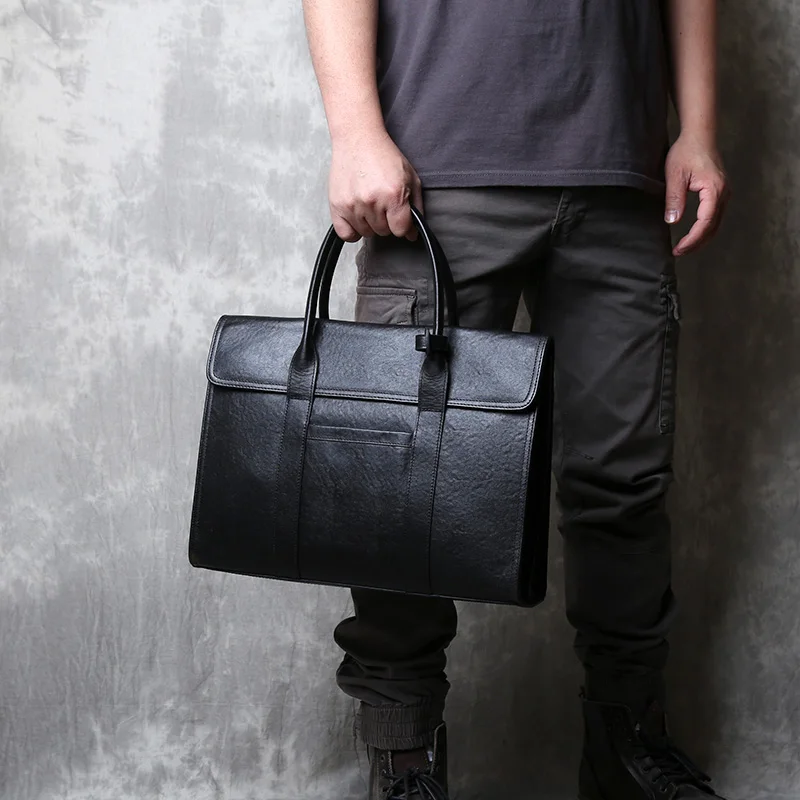
For specific stains, adapt your approach: ink stains may require specialized leather ink removers, while oil stains might benefit from absorbent powders like cornstarch. Water stains usually respond well to evening out the moisture across a larger area, then allowing the entire section to dry naturally.
Cleaning frequency depends on usage, but a thorough cleaning every 1-3 months is appropriate for regularly used briefcases. For more detailed instructions on specialized cleaning techniques, our definitive guide cleaning maintaining office leather bags provides comprehensive information for various scenarios.
Conditioning: Nourishing Your Leather for Suppleness and Strength
After cleaning, conditioning is the next critical step in leather maintenance. Conditioning replaces essential oils that evaporate over time, preventing leather from drying, cracking, and losing its suppleness. Here’s how to condition effectively:
Ensure readiness: Your briefcase must be completely clean and dry before conditioning.
Select the right conditioner: Choose one specifically formulated for your leather type. Full-grain leathers generally benefit from natural-based conditioners, while finished leathers may work better with synthetic options.
Apply properly:
– Use a clean cloth or applicator pad
– Apply a small amount of conditioner in a thin, even layer
– Work in small circular motions
– Cover all leather surfaces, including handles and trim
– Pay extra attention to creases and stress pointsAllow proper absorption: Let the conditioner penetrate for the time recommended by the manufacturer (typically 15-30 minutes).
Buff gently: Remove excess conditioner with a clean, dry cloth using circular motions until the leather no longer feels tacky.
Conditioning frequency varies based on several factors. In dry climates, condition every 3-4 months; in humid environments, every 4-6 months is usually sufficient. Usage patterns also matter—daily-use briefcases need conditioning more frequently than occasionally used ones. Seasonal changes affect leather too, with winter’s dry indoor heating often requiring additional conditioning.
Watch for signs of under-conditioned leather: stiffness, a dry appearance, or small cracks forming. Conversely, over-conditioned leather appears darkened, feels greasy, or may develop soft spots. Finding the right balance is key for brown leather briefcase care, as conditioning affects both the feel and appearance of this popular color variation.
Protection: Creating a Barrier Against the Elements
After cleaning and conditioning, the final step in basic leather care is protection. This creates a barrier against moisture, stains, and environmental factors:
Protection Methods:
Commercial leather protector sprays: Provide invisible protection against water and light stains. Apply by spraying evenly from 8-12 inches away, covering the entire surface with two light coats rather than one heavy application.
Natural wax-based protectors: Offer more substantial protection but may slightly darken leather. Apply sparingly with a cloth using circular motions, then buff to a soft sheen.
Leather creams with protective properties: Combine conditioning and protection in one product, though the protective element is usually lighter than dedicated protectors.
Protection should be applied after conditioning, once the leather has fully absorbed the conditioner and feels dry to the touch. For most briefcases, applying protector twice yearly—before winter and before spring—provides adequate coverage.
Set realistic expectations about what protection can achieve. Quality protectors make leather resistant to water and stains, not completely waterproof. After applying protection, test by dropping a small amount of water on the surface—it should bead up rather than immediately absorb.
For leather briefcases used in demanding conditions, more frequent protection may be necessary. Understanding how proper protection contributes to the longevity of an ideal leather briefcase helps justify the time investment in this final maintenance step.
Addressing Common Leather Briefcase Issues: Restoration Techniques
Even with diligent care, leather briefcases eventually develop issues that require specific restoration techniques:
Light Scratches and Scuffs
– For minor scratches, gently rub with your fingertip—natural oils often diminish their appearance
– Apply a small amount of conditioner to the affected area, then buff gently
– For more persistent scratches, specialized leather balms that match your briefcase color can fill and blend the damage
Water Spots and Rain Damage
– For fresh water exposure, blot (don’t rub) with an absorbent cloth
– For water spots, slightly dampen the entire panel to even out moisture, then allow to dry naturally
– After drying, apply conditioner to restore moisture balance
Oil and Grease Stains
– Blot excess oil immediately without rubbing
– Apply absorbent powder (cornstarch, baking soda) and leave overnight
– Brush away powder and repeat if necessary
– Clean and condition after stain removal
Ink Stains
– Address immediately with a leather ink remover designed for your leather type
– For set-in stains, professional help is often the best option
– Never use alcohol-based products on leather unless specifically formulated for ink removal
Color Fading or Wear
– Apply color-matched leather cream or polish
– For significant fading, consider professional re-dyeing
– Always test color products on an inconspicuous area first
Hardware Issues
– Clean tarnished hardware with appropriate metal cleaners
– Lubricate sticky zippers with a wax-based product designed for leather goods
– Consider professional replacement for broken hardware to ensure proper installation
Many minor issues can be addressed at home, but significant damage—torn stitching, major stains, or structural problems—usually requires professional attention. For specific guidance on removing difficult stains from your leather briefcase, our cleaning stains leather bags guide offers specialized techniques for various contaminants.
Men's Classic Leather Briefcase, Slim Leather Laptop Briefcase, Slim Leather Portfolio Briefcase
$93.67 Select options This product has multiple variants. The options may be chosen on the product pageClassic Laptop Briefcase, Men's Classic Leather Briefcase, Slim Leather Attache Case
Price range: $353.50 through $360.81 Select options This product has multiple variants. The options may be chosen on the product pageBlack Leather Briefcase, Leather Document Bag, Men's Classic Leather Briefcase
Genuine Crocodile Leather Executive Briefcase with Password Lock – Premium Business Document Carrier$1,201.87 Select options This product has multiple variants. The options may be chosen on the product pageBlack Leather Briefcase, Classic Laptop Briefcase, Men's Classic Leather Briefcase, Slim Leather Laptop Briefcase
$228.72 Select options This product has multiple variants. The options may be chosen on the product pageBrown Leather Briefcase, Classic Laptop Briefcase, Crazy Horse Leather Satchel, Men's Classic Leather Briefcase
Price range: $172.15 through $200.02 Select options This product has multiple variants. The options may be chosen on the product pageCrazy Horse Leather Satchel, Men's Classic Leather Briefcase, Men's Leather Satchel
Price range: $400.93 through $401.06 Select options This product has multiple variants. The options may be chosen on the product page
Proper Storage: Preserving Your Briefcase When Not in Use
Proper storage is crucial for maintaining your briefcase’s shape and condition when not in use:
Optimal Storage Conditions:
– Temperature: Maintain between 60-75°F (15-24°C)
– Humidity: Keep between 40-60% relative humidity
– Light: Store away from direct sunlight to prevent fading
– Air circulation: Allow leather to breathe by avoiding airtight containers
Proper Storage Techniques:
– Stuff the interior with acid-free tissue paper to maintain shape
– Use a cotton dust bag rather than plastic covers, which trap moisture
– Store upright if possible, or lay flat without placing items on top
– Keep away from heating vents, radiators, and damp areas
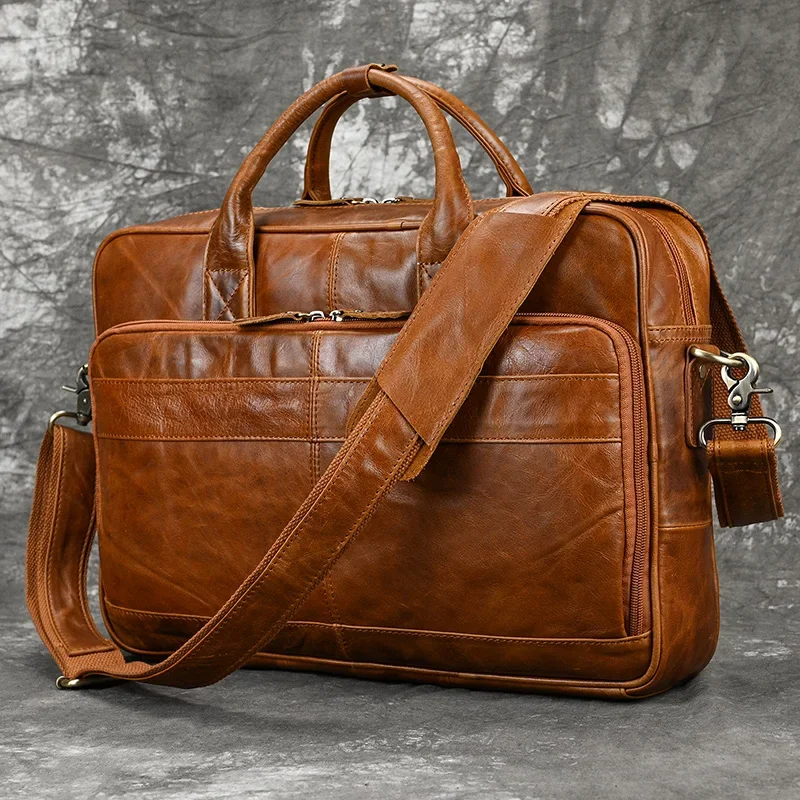
For daily use, simply emptying your briefcase and allowing it to rest in its natural shape is sufficient. For long-term storage (over a month), more careful preparation is necessary. Clean and condition the leather before storage, stuff it properly, and place it in a dust bag in a climate-controlled closet.
Seasonal storage requires special attention. Before storing a winter-use briefcase for summer, thoroughly clean, condition, and protect it. Check on stored briefcases periodically to ensure no mold or mildew is developing, particularly for classic laptop briefcases that may have electronic residue or magnetic closures that require specific attention during storage.
Special Care for Different Leather Types and Finishes
Different leather varieties require specialized care approaches:
| Leather Type | Cleaning | Conditioning | Special Considerations |
|---|---|---|---|
| Full-grain | Gentle pH-balanced cleaner | Natural-based conditioners | Develops patina; embrace minor marks |
| Top-grain | Leather cleaner for finished leather | Lighter conditioning | More stain-resistant but still requires regular care |
| Corrected-grain | Standard leather cleaner | Synthetic conditioners work well | Most durable against stains; least natural aging |
| Suede/Nubuck | Specialized suede brush and cleaner | Suede-specific protector only | Never apply standard leather conditioner; use only products specifically for suede |
| Patent Leather | Gentle soap and water | Specialty patent leather products | Avoid standard conditioners; use patent-specific products |
| Vegetable-tanned | Minimal cleaning with damp cloth | Natural conditioners | Develops rich patina with exposure to sunlight |
| Chrome-tanned | Standard leather cleaners | Responds well to most conditioners | Often more water-resistant initially |
Each leather type develops a different aging pattern. Vegetable-tanned leather darkens beautifully with exposure to sunlight and develops a rich patina with handling. Chrome-tanned leathers maintain their original color longer but may not develop the same character.
For textured leathers (like pebbled finishes), use a soft brush to clean within the texture before applying products. When conditioning, ensure the product reaches into all the textured areas.
Understanding these variations is essential when choosing the perfect leather briefcase for your needs, as maintenance requirements should factor into your decision alongside appearance and functionality.
Common Mistakes to Avoid in Leather Briefcase Care
Avoiding these common errors will significantly extend your briefcase’s lifespan:
Harmful Cleaning Practices
– ❌ Using household cleaners (Windex, Clorox, etc.) on leather
– ✓ Use only pH-balanced cleaners formulated specifically for leather
Improper Drying Methods
– ❌ Using hair dryers, heaters, or direct sunlight to speed drying
– ✓ Allow wet leather to dry naturally at room temperature
Conditioning Errors
– ❌ Over-conditioning with too much product
– ✓ Apply thin layers and remove excess
Storage Mistakes
– ❌ Storing in plastic bags that trap moisture
– ✓ Use cotton dust bags that allow airflow
Environmental Exposure
– ❌ Leaving leather in hot cars or direct sunlight
– ✓ Store in moderate temperatures away from UV exposure
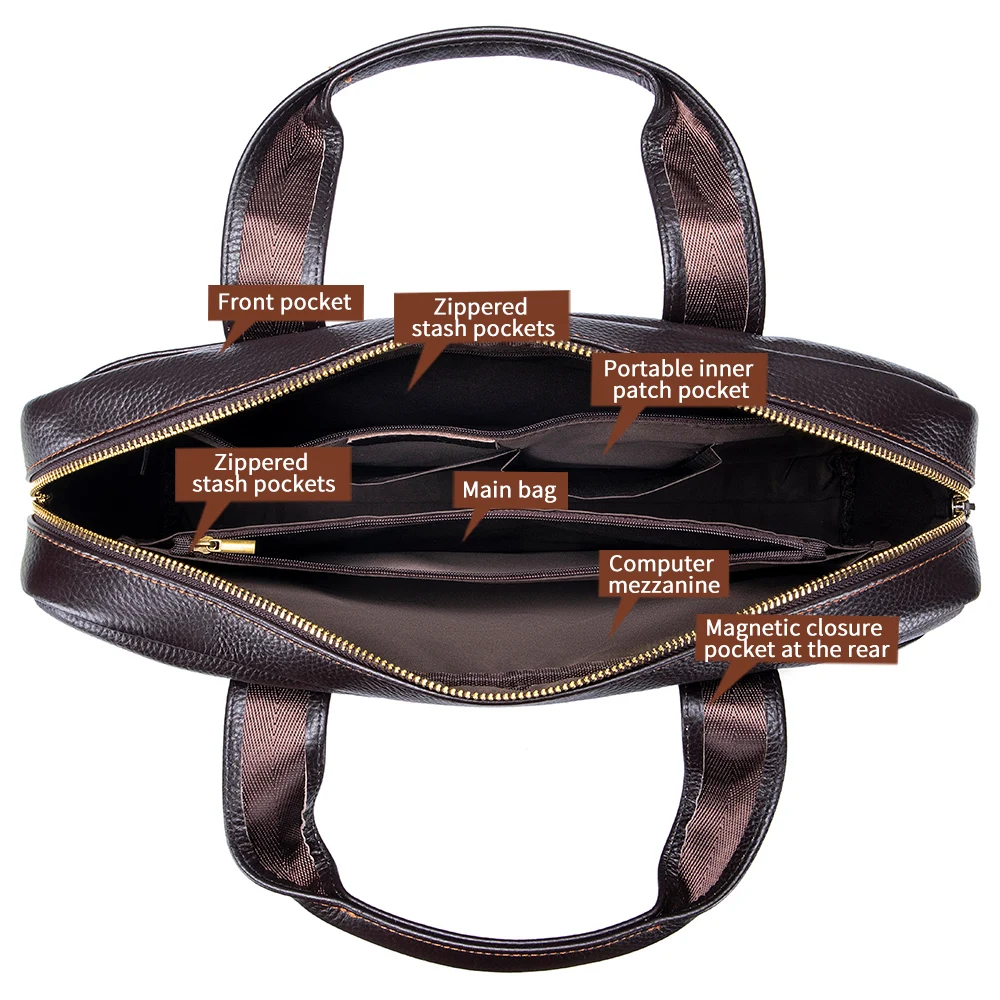
Shape Distortion
– ❌ Overstuffing pockets and compartments
– ✓ Maintain reasonable capacity and restore shape during storage
Product Compatibility
– ❌ Using products designed for different leather types
– ✓ Match cleaning and conditioning products to your specific leather
If you’ve already made one of these mistakes, don’t panic. Many can be remedied: over-conditioning can be corrected by gently wiping with a clean cloth, while under-conditioning simply requires proper application. More serious issues like water damage or chemical exposure should be addressed quickly, potentially with professional help.
For comprehensive information about ongoing maintenance, our caring leather work bag guide provides additional insights on avoiding common pitfalls.
When to Seek Professional Leather Repair
While routine maintenance can be handled at home, certain situations call for professional expertise:
Scenarios Requiring Professional Help:
– Structural damage including torn seams or handle attachment points
– Severe staining that persists after appropriate home treatment
– Color restoration when significant fading or discoloration has occurred
– Hardware replacement requiring disassembly or new attachment points
– Lining repair or replacement when torn or significantly soiled
– Water damage that has caused leather to warp or stiffen dramatically
Finding qualified leather repair professionals requires research. Look for specialists with:
– Experience specifically with fine leather briefcases and bags
– Before/after photos of similar repair work
– Clear communication about processes and limitations
– Reasonable timeframe expectations (quality repairs aren’t rushed)
Professional repairs for quality briefcases typically range from $50-$200 depending on the complexity, with structural repairs costing more than surface restoration. When evaluating repair services, ask about their experience with your specific type of leather, what products they use, and their approach to matching colors and finishes.
For valuable briefcases or those with sentimental importance, professional repair is often worth the investment, especially for leather document bag styles that may have specialized compartments requiring expert attention.
Advanced Maintenance: Creating a Long-Term Care Schedule
Transforming individual maintenance tasks into a sustainable care routine ensures your briefcase remains in excellent condition:
Daily (30 seconds)
– Wipe down exterior with soft cloth
– Check for spots or spills
– Empty contents when not in use
Weekly (5 minutes)
– Thorough dusting of exterior and seams
– Quick inspection for developing issues
– Light cleaning of interior
Monthly (15-20 minutes)
– Complete cleaning of exterior
– Hardware check and cleaning
– Thorough interior cleaning
Quarterly (30 minutes)
– Deep cleaning of all surfaces
– Conditioning treatment
– Assessment of wear points
Bi-annually (15 minutes)
– Protection application
– Edge coating touch-up if needed
Annually
– Professional assessment if needed
– Thorough check of all components
– Structural evaluation
This schedule should be adjusted based on usage patterns and environmental conditions. Those who use their briefcase daily in challenging environments (frequent rain, high humidity, extreme temperatures) should condense this timeline, while those who use their briefcase occasionally can extend intervals between deeper maintenance tasks.
Creating calendar reminders for quarterly and bi-annual tasks helps establish consistent care habits. Many briefcase owners find it helpful to document their maintenance history, especially for valuable pieces, noting products used and any professional services performed.
Is It Worth Maintaining an Older Leather Briefcase?
Many professionals wonder whether to restore an aging briefcase or simply replace it. Here’s how to make that decision:
When Restoration Makes Sense:
– The briefcase is made of high-quality, full-grain leather that has aged well
– The core structure remains sound (stitching intact, no significant tears)
– Hardware functions properly or can be reasonably replaced
– The briefcase has sentimental or historical value
– The original craftsmanship was exceptional
When Replacement Might Be Better:
– The leather shows signs of delamination or cracking throughout
– Multiple structural failures exist (torn seams, separated layers)
– The cost of comprehensive repairs exceeds 50% of replacement value
– The briefcase was made with bonded or low-quality leather
Quality indicators that suggest restoration worthiness include hand-stitching, solid brass hardware, full-grain leather that has developed a patina rather than worn away, and a solid structure despite surface wear. In many cases, a well-made vintage briefcase that’s properly restored will outlast and outperform many new briefcases made with inferior materials.
The craftsmanship found in certain vintage briefcases often exceeds modern mass-produced alternatives, making maintenance worthwhile. For guidance on identifying truly exceptional briefcases worth maintaining, our collection of top-rated classic leather briefcases demonstrates the quality benchmarks that justify ongoing care investments.
With proper maintenance, your leather briefcase will not only serve you well for many years but will develop a rich character that reflects your professional journey—becoming more distinguished and unique with every passing year.

